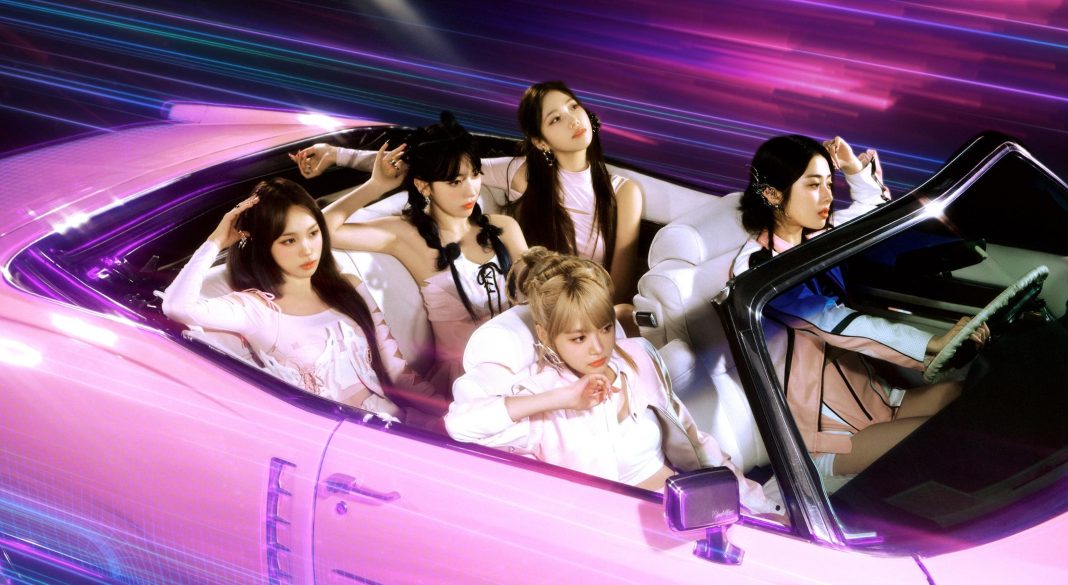This week, K-pop breakout stars Le Sserafim have found themselves in hot water after the release of their music video for comeback single ‘Easy’, filmed in the very same church where My Chemical Romance made the legendary ‘Helena’.
Shot in Los Angeles with visual artist Nina McNeely as choreographer/director, ‘Easy’ is a slick slice of hip-hop for the group; the neon-lit church setting reflecting their message of perseverance and striving towards new kinds of light. But while some fans argue that they sought appropriate permissions and had every right to stage their vision in this venue, others feel that a display of sexy outfits, sexier dancing and overgrown fauna was disrespectful in a religious venue, unbecoming of such a culturally influential group.
Since origin, Le Sserafim’s aesthetic has always been on the edgier side of the genre.
Originally debuting as a six in 2022, the members were recruited from various artistic backgrounds and traineeships – Kim Chaewon and Sakura recast from the now-defunct group IZ*ONE, Huh Yunjin lured back into K-Pop after pursuing academic study, Kazuha working as a professional ballerina and Hong Eunchae, the baby of the group, debuting at the age of only 15. With fellow member Kim Ga-ram leaving the group due to a scandal over which she allegedly bullied a classmate (or seemingly, rather stuck up for a friend who was the victim of leaked intimate photos), Le Sserafim’s reputation as girl power boundary-challengers was set early, and backed up by their very name – an acronym for the phrase ‘I’m Fearless’.
Having worked with HYBE founder Bang Si Hyuk as executive producer, Le Sserafim came out of the gates swinging. In K-pop, artistic backstory and group motivation are essential, and in showing their dedication to marching on with bravery and frankness, the mini-EPs ‘Fearless’ and ‘Antifragile’ demonstrated that they were intent on pushing back against conventions of ultra-feminine Cinderella womanhood and making use of fallen angel imagery: broken wings, devil horns, glowing eyes. Their album debut ‘Unforgiven’ deepened this versatility, drawing on feminist folklore, pulsing EDM and sincere fan service to create something quite distinct.
“‘Unforgiven’ is our message to the world that we will together walk down the path we think is right, and we are not asking for forgiveness on the way from anyone in what we believe,” said the group’s leader Chaewon at a showcase last year. Le Sserafim’s official fandom name, “FEARNOT,” (a homonym of “blooming” in Korean) is part of this canon, as is their clear determination to make music that resonates worldwide.
While the idea of the ‘fallen angel’ isn’t strictly mentioned within Catholicism, an exploration of what it means to feel rejected from God’s image is a compelling narrative for a group that connection with young audiences. But given how readily they have already played with subversive imagery and biblical references, it’s interesting that now, on their most explicitly hip-hop-orientated comeback, the criticism has fully flared up.
In some ways, a ‘satanic panic’ scandal is probably a sign of how far Le Sserafim’s music is travelling. It’s even become a bit of a right of passage for artists in Western markets, looking to challenge boundaries of sexual conservativism. Lil Nas X, Sabrina Carpenter, Demi Lovato and Sam Smith x Kim Petras have all evoked the kind of evangelical horror that was first present particularly in the 1980s, revved up again in the context of the culture wars, increasing pressure on artists to push boundaries in the name of achieving a shocking, viral moment.
Even in K-pop, there have been various examples of where bands have played with church-related imagery or dark subversions of faith to make a point about their increasing maturity, or to reach new markets. SHINee soloist Taemin, for example, is an open catholic, but surprised fans when he donned a dark veil and crown of thorns for the teaser images of his solo album ‘Never Gonna Dance Again – Act 2’, whilst BTS made use of black wings, Virgin Mary and Last-Supper imagery in the video for ‘Blood Sweat and Tears’ back in 2016, drawing significant controversy.
To assume that Le Sserafim are merely attempting to cash in on a little scandal is not really the sum of what’s going on with ‘Easy’, or with the group’s wider image. As the title track of their new mini-album, the song actually talks about the feeling of vulnerability, and how much effort and consideration it takes behind the scenes to maintain their cool, confident demeanour. Going beyond the kind of ‘‘lucky girl syndrome’ that pervades social media, their goal is to dismantle some of the pressures of perfection and saintliness in a way that feels pretty knowingly provocative by Korean standards. As one Reddit user argues, the aesthetic use of rosaries, crosses and other religious symbols is not always tasteful, but perhaps part and parcel of reading Catholicism through history and culture rather than through faith, reflecting on what the idea of religious conservativism has come to symbolise: “For them… It’s respected, but not sacralised. [K-Pop stars] use Christianity in pop culture in the same way they use, say, Greek mythology…it’s your God to worship, not theirs.”
Of course, Christian K-pop fans have every right to decide that Le Sserafim is not the group for them. It’s difficult to argue against the idea that a similarly raunchy music video filmed in a Mosque or Synagogue wouldn’t cause deep outrage, or that Christianity isn’t made an easy target for artists trying to create aesthetic shorthand for rebellion. As with all kinds of music or artistic action, it’s not for us to say what people should or shouldn’t like, or to claim that this kind of imagery doesn’t have any potential to cause discomfort or offence. But to take umbrage with ‘Easy’ now is perhaps a little like trying to lock the barn door after the horse has bolted, missing the clues that have been there all along. Whilst Le Sserafim have a huge platform, they are not responsible for being all things to all people, and have always been pretty clear about the messages that they wish to stand for as a group, a proverbial Phoenix rising from life’s messy, contradictory ashes.
Even within Hybe’s roster, they are carefully marketed in contrast to fellow success story NewJeans, who provide a sweeter, cuter teenage aesthetic that is more in line with traditional readings of K-pop. Across the genre, there are many different manifestations of faith, culture, and femininity for fans to enjoy. But with Le Sserafim’s emphasis on lore, history and rebellion, it’s inevitable that they will push conservative and religious buttons, even if ultimately, it all comes from a place of trying to widen the dialogue of what it means to be a young Korean woman. The road may not be easy, but they’re hell-bent on fighting for their right to travel it — broken wings and all.








What’s also interesting is that a saraphim is a six-winged celestial being. Their name is that of an angel, but their music is about them being imperfect humans that shouldn’t be idolized. Aside from that, they have lyrics referring to witches and dance moves with devil horns, and I personally thinks that is about how society perceives them. They get unrealistic expectations to be perfect angels, while also being viewed as devils and the root of all evil because they are women (like Eve from the bible and the witch hunts throughout history). This is just my interpretation. I know it is difficult to say you are a feminist openly in Korea, but these are very powerful analogies.